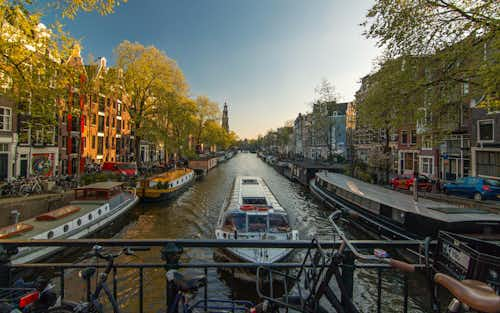Spanning the history of Amsterdam and that of its centuries-old Jewish community - their multi-faceted influence on the city, and their experiences during the Holocaust – the Anne Frank Walking Tour is a deep dive into an unforgettable chapter of human history. Central to the tour is the inspiring yet sobering story of Anne Frank, a young, Jewish wartime diarist, who lived through years of Nazi occupation, in Amsterdam, and tragically succumbed in a concentration camp a few weeks before the war ended.
The Anne Frank Walking Tour recasts Amsterdam in a different light, encouraging you to embrace its rich and textured history, retrace the deeply moving life of Anne Frank, and reexamine one of the darkest times humankind has faced. A must for history buffs and those who want to discover Amsterdam beyond its heady party scene, the Anne Frank Walking Tour is an unforgettable experience.
Who was Anne Frank?

In 1934, a year after Hitler assumed his role as Chancellor of the Reich and the Nazi Party began in earnest its persecution of the Jews, the Franks, a liberal Jewish family, fled Frankfurt and settled in Amsterdam. Just over four years old, Frank, her parents and older sister began living in the city’s Rivierenbuurt neighbourhood, which had become a haven for Jewish refugees.
It’s little wonder that the Franks along with thousands of other Jews, during that time, chose Amsterdam as their refuge. After all, the city had long been known as religiously tolerant and had welcomed, since the 16th and 17th centuries, persecuted Jews from countries like Portugal and Spain.
Black-and-white photos from Anne’s early years in Amsterdam show a smiling girl often playing in the city streets, hanging out arm-in-arm with a group of friends, and even posing seriously in front of her father’s business office.
The joy, however, was short-lived as the Nazis invaded Amsterdam in 1940. In June 1942, Frank, an aspiring writer, received an autograph book covered in red and white checks for her 13th birthday. She christened it ‘Kitty’ and began writing about her life. A month later, the Franks entered the ‘Secret Annexe’ a hideout at Frank’s father’s business office and spent the next two years in hiding.
Throughout these years, Frank wrote regularly in her diary, detailing her life in the cramped Annexe, which the Franks came to share with two other families. As she matured, Frank’s diary entries delved into themes of faith, love, hope and resilience. She repeatedly spoke of her dreams for the future and her wish to be a writer.
In the early hours of August 4, 1944, German police discovered and stormed the Annexe, arresting all of its inhabitants, including, 15-year-old Frank. First deported to Auschwitz, where she was forced to take up hard labour, and then to Bergen-Belsen concentration camp in Germany, Frank died between February and March of 1945. British troops liberated the camp only weeks later in April 1945.
Otto Frank, Anne’s father who was the only family member to survive the Holocaust, received her well-preserved diaries from his former associates in Amsterdam. Honouring her wish to be a writer, he published the diaries. “The Diary of a Young Girl” has since been translated into over 70 languages and sold millions of copies worldwide, making Anne Frank the best-known Jewish wartime diarist from World War II.
Anne Frank Walking Tour itinerary

- Starting the tour at the steps of the recognised Jewish Historical Museum, you step into Amsterdam’s Jewish Quarter whose origins go back to the 15th century. As you walk through the neighbourhood, the guide outlines Amsterdam’s history as a city that opened its doors to the Sephardic Jews, who left Spain and Portugal after facing increasing persecution from Christian monarchies in the 15th and 16th centuries.
- As you go along, the guide recounts the emergence of the Sephardic Jews as an influential community that left their mark on the social, economic and cultural fabric of Amsterdam. This is reflected in the affluent historical homes of Sephardic Jews that you’ll stop by on your tour. You even take a closer look at Rembrandt’s work which was influenced by Amsterdam’s thriving Jewish community.
- The tour then skips ahead to the1940s, with the next influx of Jews, arriving from Germany, as Hitler gained power. Interwoven into this narrative is the story of Anne Frank, a little girl who arrived in Amsterdam with her family, seeking safety and freedom.
- As the lives of Anne Frank and thousands of Jews like her unfolded in the Jewish neighbourhoods of Amsterdam, the story of the Holocaust took shape and you spend poignant moments at the city’s Auschwitz Memorial, National Holocaust Names Memorial and the Portuguese Synagogue, that has stood since the 17th century and has borne witness to the Nazi genocide.
- You also learn about Dutch protests against the Holocaust and how dock workers united on the streets of the city to raise their voices against the persecution and killing of Jews. The guide also unpacks the Dutch famine, known as the Hunger Winter, when Germany cut off the supply of food, fuel and other essentials to The Netherlands in retaliation for the support the country extended to the Allies. The Hunger Winter lasted between 1944 and 1945 and resulted in the death of 20,000 people across the country.
- Finally, the tour winds up at the steps of Anne Frank House and you are given a detailed account of how the young Jewish girl and her family lived in the shadow of Nazi terror in a hidden part of the building that housed her father’s business. The building, which is now the Anne Frank House, is where Frank lived with her family and two others and produced a detailed account of her life and her hopes and dreams. While the 15-year-old did not survive the Holocaust, her immortal diary lives on, touching the lives of millions across the world.

🕙 Anne Frank Walking Tour timings
There are two walking tours scheduled every day – at 11.30am and 3pm.
📍 Departure point
The Anne Frank Walking Tours starts right outside the Jewish Historical Museum at Nieuwe Amstelstraat 1. Your guide will be wearing a red name tag around their neck.
📍 Drop off point
The tour ends outside Anne Frank House. The tour does not include tickets to Anne Frank House and you will have to book your own.
⏳ Anne Frank Walking Tour duration
The Anne Frank Walking Tour lasts for about two hours.
🛈 Know before you book
- Children below the age of three need not buy a ticket.
- For those aged between nine and 12, the tour is discounted and is priced at 15 euros per child.
- Many parts of the tour are not wheelchair accessible.
- Guide dogs are permitted on the tour.
Ready for your Amsterdam visit?
Here's more of what you can explore in Amsterdam.






